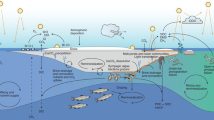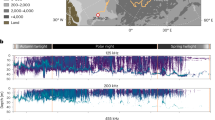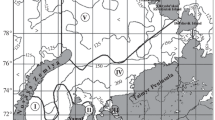Abstract
Understanding the flow of solar energy into ecosystems is fundamental to understanding ecosystem productivity and dynamics. To gain a better understanding of this fundamental process in the Antarctic winter sea ice, we produced a model that estimates the time-integrated exposure of seasonal Antarctic sea ice to PAR through the use of remotely sensed sea ice concentrations, sea ice movement and spatially distributed PAR calculations that account for cloud cover and have applied this model over the past three decades. The resulting spatially distributed estimates of sea ice exposure to PAR by mid-winter are evaluated in context of changes in the timing of sea ice formation that have been documented along the Western Antarctic Peninsula (WAP) region and its potential effects on the variation (seasonal and inter-annual) in the accumulation of sea ice algae in this region. The analysis shows the ice pack is likely to have large inter-annual variations (10–100 fold) in productivity throughout the autumn to winter transition in the sea ice along the WAP. Moreover, the pack ice is likely to have spatial structure in regards to biological processes that cannot be determined from analysis of sea ice concentration information alone. The resulting inter-annual variations in winter processes are likely to affect the dynamics of Antarctic krill (Euphausia superba).






Similar content being viewed by others
Abbreviations
- PAR:
-
Photosynthetically active radiation
- TIEP:
-
Time-integrated exposure to PAR
- SIMCOs:
-
Sea ice microbial communities
- WAP:
-
Western Antarctic Peninsula
- Chl a :
-
chlorophyll a
- SO-GLOBEC:
-
Southern Ocean Global Ocean Ecosystems Dynamics
References
Ackley SF, Sullivan CW (1994) Physical controls on the development and characteristics of Antarctic sea ice biological communities: a review and synthesis. Deep Sea Res part 2 Top Stud Oceanogr 41:1583–1604
Arrigo KR, Worthen DL, Lizotte MP, Dixon P, Dieckmann G (1997) Primary production in Antarctic sea ice. Science 276:394–397
Atkinson A, Stubing D, Hagen W, Schmidt K, Bathmann UV (2002) Feeding and energy budgets of Antarctic krill Euphausia superba at the onset of winter- II. Juveniles and adults. Limnol Oceanogr 47:953–966
Atkinson A, Siegel V, Pakhomov E, Rothery P (2004) Long-term decline in krill stock and increase in salps within the Southern Ocean. Nature 432:100–103
Comiso J (1999, updated 2008) Bootstrap sea ice concentrations from NIMBUS-7 SMMR and SMSP SSM/I, 01 March 1979 to 31 December 2007. National Snow and Ice Data Center, Boulder, CO USA, Digital Media
Daly KL (1990) Overwintering development, growth, and feeding of larval Euphausia superba in the Antarctic marginal ice zone. Limnol Oceanogr 35:1564–1576
Dieckmann GS, Eicken H, Haas C et al (1998) A compilation of data on sea ice algal standing crop from the Bellingshausen, Amundsen and Weddell Seas from 1983 to 1994. In: Lizotte MP, Arrigo K (eds) Antarctic Sea ice biological processes, interactions, and variability, vol 73. Am Geophys Union, Washington, pp 85–92
Eicken H, Lange MA, Dieckmann GS (1991) Spatial variability of sea-ice properties in the northwestern Weddell Sea. J Geophys Res 96:10603–10615
Fetterer F, Knowles K, Meier W, Savoie M (2002, updated 2009) Sea ice index. National Snow and Ice Data Center, Boulder, CO USA, Digital Media
Forsythe WC, Rykiel EJJ, Stahl RS, Wu H-i, Schoolfield RM (1995) A model comparison for daylength as a function of latitude and day of year. Ecol Model 80:87–95
Fowler C (2003, updated 2007) Polar pathfinder daily 25 km EASE-grid sea ice motion vectors national snow and ice data center, Boulder, CO USA, Digital media
Fritsen CH, Lytle VI, Ackley SF, Sullivan CW (1994) Autumn bloom of Antarctic pack-ice algae. Science 266:782–784
Fritsen CH, Memmott J, Stewart FJ (2008) Inter-annual sea-ice dynamics and micro-algal biomass in winter pack ice of Marguerite Bay, Antarctica. Deep Sea Res part 2 Top Stud Oceanogr 55:2059–2067
Garrison DL, Close AR, Reimnitz E (1989) Algae concentrated by frazil ice: evidence from laboratory experiments and field measurements. Antarct Sci 1:313–316
Hofmann EE, Klinck JM, Costa DP et al (2002) U.S. Southern ocean global ocean ecosystems dynamics program. Oceanography 15:64–74
Horner R (1984) Phytoplankton abundance, chlorophyll a, and primary productivity in the western Beaufort Sea. In: Barnes PW, Schell DM, Reimnitz E (eds) The Alaskan Beaufort Sea: ecosystems and environments. Academic Press, London, pp 295–310
Hoshiai T (1985) Autumnal proliferation of ice-algae in Antarctic sea-ice. In: Siegfried WR, Condy PR, Laws RM (eds) Antarctic nutrient cycles and food webs. Springer, Berlin, pp 89–92
Hoshiai T, Tanimura A, Kudoh S (1996) The significance of autumnal sea ice biota in the ecosystem of ice-covered polar seas. Polar Biol 9:27–34
Kidner D, Dorey M, Smith D (1999) What’s the point? Interpolation and extrapolation with a regular grid DEM. http://www.geocomputation.org/1999/082/gc_082.htm
Legendre L, Rochet M, Demers S (1986) Sea-Ice microalgae to test the hypothesis of photosynthetic adaptations to high frequency light fluctuations. J Exp Mar Biol Ecol 97:321–326
Meguro H (1962) Plankton ice in the Antarctic Ocean. Rep Japanese Antarct Res Expedition. 1192–1199
Meyer B, Oettl B (2005) Effects of short-term starvation on composition and metabolism of larval Antarctic krill Euphausia superba. Mar Ecol Prog Ser 292:263–270
Morel A, Smith RC (1974) Relation between total quanta and total energy for aquatic photosynthesis. Limnol Oceanogr 19:591–600
Parson TR, Maita Y, Lalli CM (1984) A manual of chemical and biological methods for seawater analysis. Pergamon Press, Oxford
Quetin LB, Ross RM (2003) Episodic recruitment in Antarctic krill, Euphausia superba, in Palmer LTER study region. Mar Ecol Prog Ser 259:185–200
Quetin LB, Ross RM, Fritsen CH, Vernet M (2007) Ecological responses of Antarctic krill to environmental variability: can we predict the future? Antarct Sci 19:253–266
Raymond B, Meiners K, Fowler CW et al (2009) Cumulative solar irradiance and potential large-scale sea ice algae distribution off East Antarctica (30A degrees E-150A degrees E). Polar Biol 32:443–452. doi:10.1007/s00300-008-0538-5
Ross RM, Quetin LB (1991) Ecological physiology of larval Euphausiids, Euphausia superba (Euphausiacea). Mem Queensl Mus 31:321–333
Siegel V, Loeb V (1995) Recruitment of Antarctic krill Euphausia superba and possible causes for its variability. Mar Ecol Prog Ser 123:45–56
Siegel V, Ross RM, Quetin LB (2003) Krill (Euphausia superba) recruitment indices from the western Antarctic Peninsula: are they representative of larger regions? Polar Biol 26:672–679. doi:10.1007/s00300-003-0537-5
Smetacek V, Scharek R, Nothig EM (1990) Seasonal and regional variation in the pelagial and its relationship to the life history cycle of krill. In: Kerry KR, Hempel G (eds) Antarctic ecosystems: ecological change and conservation. Springer, Berlin, pp 103–114
Smith RC, Baker KS, Fraser WR et al (1995) The Palmer LTER: a long-term ecological research program at Palmer Station, Antarctica. Oceanography 8:77–86
Stammerjohn SE, Martinson DG, Smith RC, Iannuzzi RA (2008) Sea ice in the Western Antarctic Peninsula region: spatio-temporal variability from ecological and climate change perspectives. Deep Sea Res Part 2 55:2041–2058. doi:10.1016/j.dsr2.2008.04.026
Thomas DN, Dieckmann GS (2002) Antarctic sea ice—a habitat for extremophiles. Science 295:641–644
Thomas DN, Lara RJ, Haas C et al (eds) (1998) Biological soup within decaying summer sea ice in the Amundsen Sea, Antarctica. American Geophysical Union, Washington
Welschmeyer NA (1994) Fluorometric analysis of chlorophyll a in the presence of chlorophyll b and pheopigments. Limnol Oceanogr 39:1985–1992
Acknowledgments
This research was supported by NSF-Office of Polar Programs grants ANT-0529666, ANT-0529087, and ANT-0528728. We thank the many contributors to engaging discussions regarding seasonal timing and potential ecosystem response over the past seasons.
Author information
Authors and Affiliations
Corresponding author
Rights and permissions
About this article
Cite this article
Fritsen, C.H., Memmott, J.C., Ross, R.M. et al. The timing of sea ice formation and exposure to photosynthetically active radiation along the Western Antarctic Peninsula. Polar Biol 34, 683–692 (2011). https://doi.org/10.1007/s00300-010-0924-7
Received:
Revised:
Accepted:
Published:
Issue Date:
DOI: https://doi.org/10.1007/s00300-010-0924-7




